Product Info Summary
| SKU: | A08685 |
|---|---|
| Size: | 100 μg/vial |
| Reactive Species: | Human, Mouse, Rat |
| Host: | Rabbit |
| Application: | Flow Cytometry, IHC, IHC-F, ICC, WB |
Customers Who Bought This Also Bought
Product info
Product Name
Anti-RMI2 Antibody Picoband®
SKU/Catalog Number
A08685
Size
100 μg/vial
Form
Lyophilized
Description
Boster Bio Anti-RMI2 Antibody Picoband® catalog # A08685. Tested in Flow Cytometry, IHC, IHC-F, ICC, WB applications. This antibody reacts with Human, Mouse, Rat. The brand Picoband indicates this is a premium antibody that guarantees superior quality, high affinity, and strong signals with minimal background in Western blot applications. Only our best-performing antibodies are designated as Picoband, ensuring unmatched performance.
Storage & Handling
Store at -20˚C for one year from date of receipt. After reconstitution, at 4˚C for one month. It can also be aliquotted and stored frozen at -20˚C for six months. Avoid repeated freeze-thaw cycles.
Cite This Product
Anti-RMI2 Antibody Picoband® (Boster Biological Technology, Pleasanton CA, USA, Catalog # A08685)
Host
Rabbit
Contents
Each vial contains 4mg Trehalose, 0.9mg NaCl, 0.2mg Na2HPO4, 0.05mg NaN3.
Clonality
Polyclonal
Isotype
Rabbit IgG
Immunogen
A synthetic peptide corresponding to a sequence at the C-terminus of human RMI2, which shares 96.3% and 92.6% amino acid (aa) sequence identity with mouse and rat RMI2, respectively.
*Blocking peptide can be purchased. Costs vary based on immunogen length. Contact us for pricing.
Cross-reactivity
No cross-reactivity with other proteins.
Reactive Species
A08685 is reactive to RMI2 in Human, Mouse, Rat
Reconstitution
Observed Molecular Weight
19 kDa
Calculated molecular weight
15.865kDa
Background of RMI2
RMI2 is a component of the BLM (RECQL3) complex, which plays a role in homologous recombination-dependent DNA repair and is essential for genome stability. This gene is mapped to 16p13.13. RMI1 and RMI2 were present in approximately stoichiometric amounts with other BLM complex components, including topoisomerase-3-alpha (TOP3A), RPA (see RPA1), and BLAP250. RMI2 also associated with RMI1 and TOP3A in a second complex. RMI1 and RMI2 interacted directly, and both were essential for stability of the BLM complex. Depletion of either RMI1 or RMI2 depleted the other protein by 80 to 90%. Chicken DT40 cells depleted of Rmi2 displayed elevated sister chromatid exchange, but other functions of the BLM complex appeared intact. Mutation analysis revealed that interaction between human RMI2 and BLM was essential for suppression of sister chromatid exchange.
Antibody Validation
Boster validates all antibodies on WB, IHC, ICC, Immunofluorescence, and ELISA with known positive control and negative samples to ensure specificity and high affinity, including thorough antibody incubations.
Application & Images
Applications
A08685 is guaranteed for Flow Cytometry, IHC, IHC-F, ICC, WB Boster Guarantee
Assay Dilutions Recommendation
The recommendations below provide a starting point for assay optimization. The actual working concentration varies and should be decided by the user.
Western blot, 0.1-0.5μg/ml
Immunohistochemistry (Paraffin-embedded Section), 0.5-1μg/ml
Immunohistochemistry (Frozen Section), 0.5-1μg/ml
Immunocytochemistry, 0.5-1μg/ml
Flow Cytometry (Fixed), 1-3μg/1x106 cells
Positive Control
WB: human Hela whole cell, human T-47D whole cell, human HepG2 whole cell, human K562 whole cell, rat thymus tissue, mouse HEPA1-6 whole cell
IHC: human intestinal cancer tissue, human intestinal cancer tissue, rat liver tissue, human mammary cancer tissue, human mammary cancer tissue, mouse liver tissue
FCM: U20S cell
Validation Images & Assay Conditions
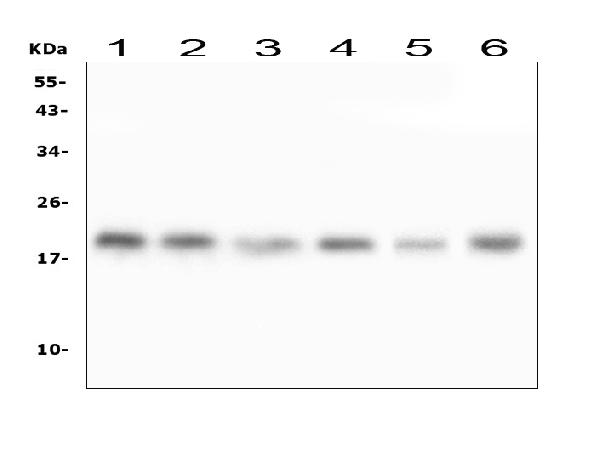
Click image to see more details
Figure 1. Western blot analysis of RMI2 using anti-RMI2 antibody (A08685).
Electrophoresis was performed on a 5-20% SDS-PAGE gel at 70V (Stacking gel) / 90V (Resolving gel) for 2-3 hours. The sample well of each lane was loaded with 50ug of sample under reducing conditions.
Lane 1: human Hela whole cell lysates,
Lane 2: human T-47D whole cell lysates,
Lane 3: human HepG2 whole cell lysates,
Lane 4: human K562 whole cell lysates,
Lane 5: rat thymus tissue lysates,
Lane 6: mouse HEPA1-6 whole cell lysates.
After Electrophoresis, proteins were transferred to a Nitrocellulose membrane at 150mA for 50-90 minutes. Blocked the membrane with 5% Non-fat Milk/ TBS for 1.5 hour at RT. The membrane was incubated with rabbit anti-RMI2 antigen affinity purified polyclonal antibody (Catalog # A08685) at 0.5 μg/mL overnight at 4°C, then washed with TBS-0.1%Tween 3 times with 5 minutes each and probed with a goat anti-rabbit IgG-HRP secondary antibody at a dilution of 1:10000 for 1.5 hour at RT. The signal is developed using an Enhanced Chemiluminescent detection (ECL) kit (Catalog # EK1002) with Tanon 5200 system. A specific band was detected for RMI2 at approximately 19KD. The expected band size for RMI2 is at 17KD.
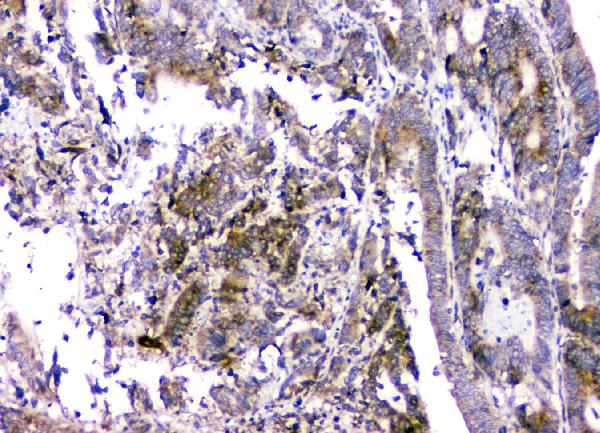
Click image to see more details
Figure 2. IHC analysis of RMI2 using anti-RMI2 antibody (A08685).
RMI2 was detected in paraffin-embedded section of human intestinal cancer tissue. Heat mediated antigen retrieval was performed in citrate buffer (pH6, epitope retrieval solution) for 20 mins. The tissue section was blocked with 10% goat serum. The tissue section was then incubated with 1μg/ml rabbit anti-RMI2 Antibody (A08685) overnight at 4°C. Biotinylated goat anti-rabbit IgG was used as secondary antibody and incubated for 30 minutes at 37°C. The tissue section was developed using Strepavidin-Biotin-Complex (SABC)(Catalog # SA1022) with DAB as the chromogen.
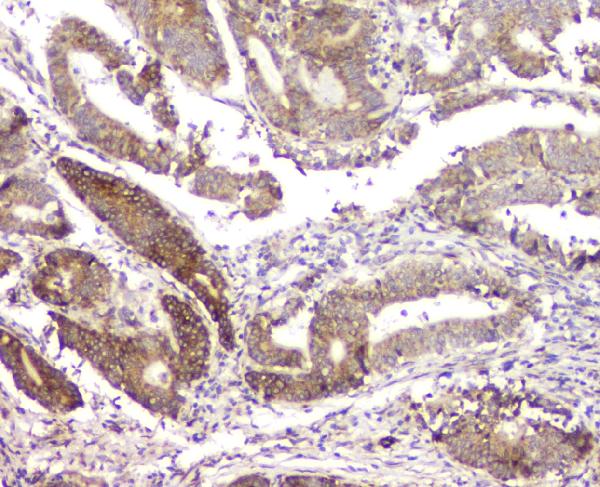
Click image to see more details
Figure 3. IHC analysis of RMI2 using anti-RMI2 antibody (A08685).
RMI2 was detected in paraffin-embedded section of human intestinal cancer tissue. Heat mediated antigen retrieval was performed in citrate buffer (pH6, epitope retrieval solution) for 20 mins. The tissue section was blocked with 10% goat serum. The tissue section was then incubated with 1μg/ml rabbit anti-RMI2 Antibody (A08685) overnight at 4°C. Biotinylated goat anti-rabbit IgG was used as secondary antibody and incubated for 30 minutes at 37°C. The tissue section was developed using Strepavidin-Biotin-Complex (SABC)(Catalog # SA1022) with DAB as the chromogen.
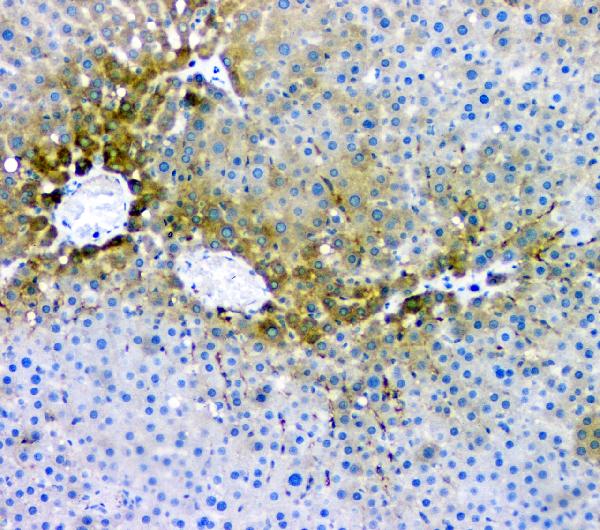
Click image to see more details
Figure 4. IHC analysis of RMI2 using anti-RMI2 antibody (A08685).
RMI2 was detected in paraffin-embedded section of rat liver tissue. Heat mediated antigen retrieval was performed in citrate buffer (pH6, epitope retrieval solution) for 20 mins. The tissue section was blocked with 10% goat serum. The tissue section was then incubated with 1μg/ml rabbit anti-RMI2 Antibody (A08685) overnight at 4°C. Biotinylated goat anti-rabbit IgG was used as secondary antibody and incubated for 30 minutes at 37°C. The tissue section was developed using Strepavidin-Biotin-Complex (SABC)(Catalog # SA1022) with DAB as the chromogen.
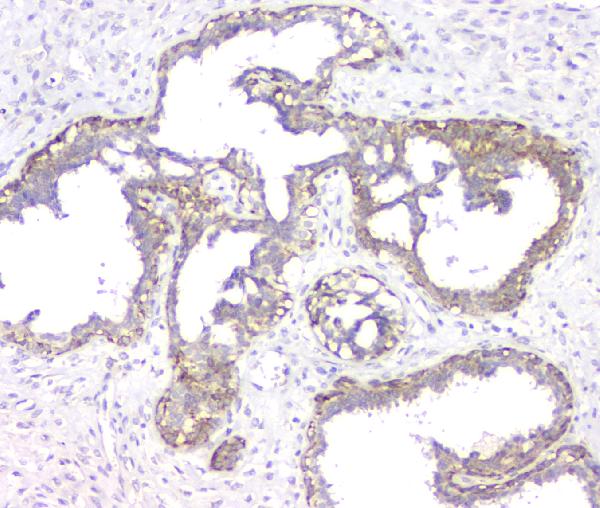
Click image to see more details
Figure 5. IHC analysis of RMI2 using anti-RMI2 antibody (A08685).
RMI2 was detected in paraffin-embedded section of human mammary cancer tissue. Heat mediated antigen retrieval was performed in citrate buffer (pH6, epitope retrieval solution) for 20 mins. The tissue section was blocked with 10% goat serum. The tissue section was then incubated with 1μg/ml rabbit anti-RMI2 Antibody (A08685) overnight at 4°C. Biotinylated goat anti-rabbit IgG was used as secondary antibody and incubated for 30 minutes at 37°C. The tissue section was developed using Strepavidin-Biotin-Complex (SABC)(Catalog # SA1022) with DAB as the chromogen.
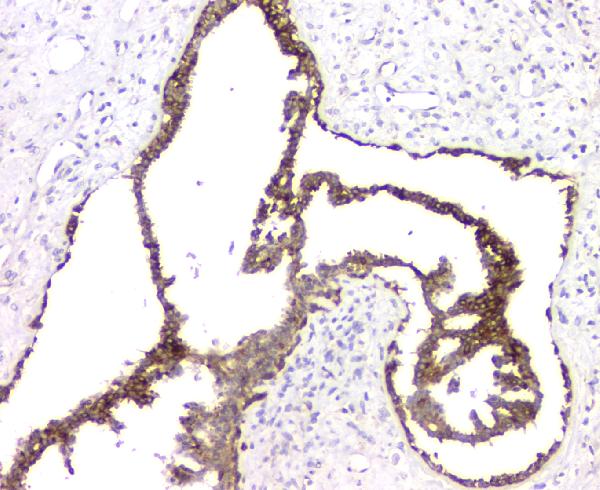
Click image to see more details
Figure 6. IHC analysis of RMI2 using anti-RMI2 antibody (A08685).
RMI2 was detected in paraffin-embedded section of human mammary cancer tissue. Heat mediated antigen retrieval was performed in citrate buffer (pH6, epitope retrieval solution) for 20 mins. The tissue section was blocked with 10% goat serum. The tissue section was then incubated with 1μg/ml rabbit anti-RMI2 Antibody (A08685) overnight at 4°C. Biotinylated goat anti-rabbit IgG was used as secondary antibody and incubated for 30 minutes at 37°C. The tissue section was developed using Strepavidin-Biotin-Complex (SABC)(Catalog # SA1022) with DAB as the chromogen.
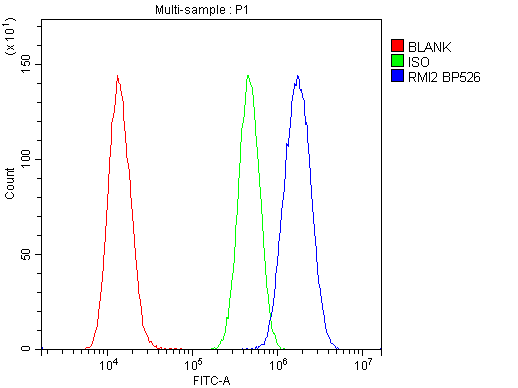
Click image to see more details
Figure 7. Flow Cytometry analysis of U20S cells using anti-RMI2 antibody (A08685).
Overlay histogram showing U20S cells stained with A08685 (Blue line). To facilitate intracellular staining, cells were fixed with 4% paraformaldehyde and permeabilized with permeabilization buffer. The cells were blocked with 10% normal goat serum. And then incubated with rabbit anti-RMI2 Antibody (A08685,1μg/1x106 cells) for 30 min at 20°C. DyLight®488 conjugated goat anti-rabbit IgG (BA1127, 5-10μg/1x106 cells) was used as secondary antibody for 30 minutes at 20°C. Isotype control antibody (Green line) was rabbit IgG (1μg/1x106) used under the same conditions. Unlabelled sample without incubation with primary antibody and secondary antibody (Red line) was used as a blank control.
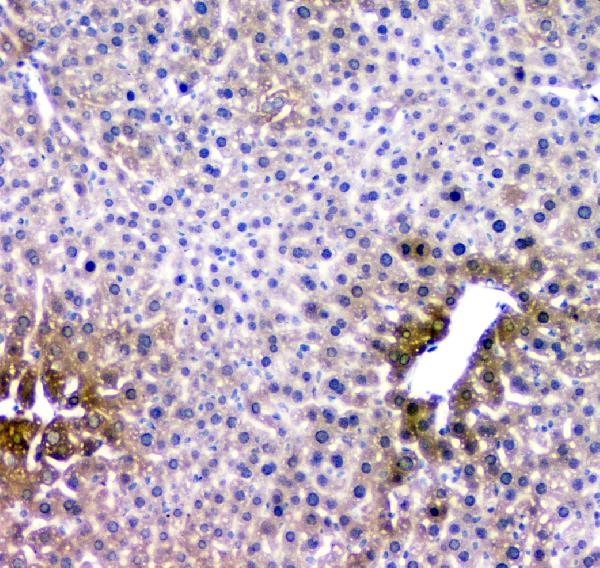
Click image to see more details
Figure 8. IHC analysis of RMI2 using anti-RMI2 antibody (A08685).
RMI2 was detected in paraffin-embedded section of mouse liver tissues. Heat mediated antigen retrieval was performed in citrate buffer (pH6, epitope retrieval solution) for 20 mins. The tissue section was blocked with 10% goat serum. The tissue section was then incubated with 1μg/ml rabbit anti-RMI2 Antibody (A08685) overnight at 4°C. Biotinylated goat anti-rabbit IgG was used as secondary antibody and incubated for 30 minutes at 37°C. The tissue section was developed using Strepavidin-Biotin-Complex (SABC)(Catalog # SA1022) with DAB as the chromogen.
Protein Target Info & Infographic
Gene/Protein Information For RMI2 (Source: Uniprot.org, NCBI)
Gene Name
RMI2
Full Name
RecQ-mediated genome instability protein 2
Weight
15.865kDa
Superfamily
RMI2 family
Alternative Names
RecQ-mediated genome instability protein 2; hRMI2; BLM-associated protein of 18 kDa; BLAP18; RMI2; C16orf75 RMI2 BLAP18, C16orf75 RecQ mediated genome instability 2 recQ-mediated genome instability protein 2|BLM-associated protein of 18 kDa|RMI2, RecQ mediated genome instability 2, homolog
*If product is indicated to react with multiple species, protein info is based on the gene entry specified above in "Species".For more info on RMI2, check out the RMI2 Infographic

We have 30,000+ of these available, one for each gene! Check them out.
In this infographic, you will see the following information for RMI2: database IDs, superfamily, protein function, synonyms, molecular weight, chromosomal locations, tissues of expression, subcellular locations, post-translational modifications, and related diseases, research areas & pathways. If you want to see more information included, or would like to contribute to it and be acknowledged, please contact [email protected].
Specific Publications For Anti-RMI2 Antibody Picoband® (A08685)
Hello CJ!
No publications found for A08685
*Do you have publications using this product? Share with us and receive a reward. Ask us for more details.
Recommended Resources
Here are featured tools and databases that you might find useful.
- Boster's Pathways Library
- Protein Databases
- Bioscience Research Protocol Resources
- Data Processing & Analysis Software
- Photo Editing Software
- Scientific Literature Resources
- Research Paper Management Tools
- Molecular Biology Software
- Primer Design Tools
- Bioinformatics Tools
- Phylogenetic Tree Analysis
Customer Reviews
Have you used Anti-RMI2 Antibody Picoband®?
Submit a review and receive an Amazon gift card.
- $30 for a review with an image
0 Reviews For Anti-RMI2 Antibody Picoband®
Customer Q&As
Have a question?
Find answers in Q&As, reviews.
Can't find your answer?
Submit your question
5 Customer Q&As for Anti-RMI2 Antibody Picoband®
Question
Does anti-RMI2 antibody A08685 work on zebrafish WB with lymph?
K. Krishna
Verified customer
Asked: 2019-09-11
Answer
Our lab technicians have not tested anti-RMI2 antibody A08685 on zebrafish. You can run a BLAST between zebrafish and the immunogen sequence of anti-RMI2 antibody A08685 to see if they may cross-react. If the sequence homology is close, then you can perform a pilot test. Keep in mind that since we have not validated zebrafish samples, this use of the antibody is not covered by our guarantee. However we have an innovator award program that if you test this antibody and show it works in zebrafish lymph in WB, you can get your next antibody for free.
Boster Scientific Support
Answered: 2019-09-11
Question
I see that the anti-RMI2 antibody A08685 works with IHC-P, what is the protocol used to produce the result images on the product page?
Verified Customer
Verified customer
Asked: 2019-08-15
Answer
You can find protocols for IHC-P on the "support/technical resources" section of our navigation menu. If you have any further questions, please send an email to [email protected]
Boster Scientific Support
Answered: 2019-08-15
Question
We are currently using anti-RMI2 antibody A08685 for rat tissue, and we are happy with the IHC-F results. The species of reactivity given in the datasheet says human, mouse, rat. Is it likely that the antibody can work on feline tissues as well?
Verified Customer
Verified customer
Asked: 2019-04-03
Answer
The anti-RMI2 antibody (A08685) has not been tested for cross reactivity specifically with feline tissues, though there is a good chance of cross reactivity. We have an innovator award program that if you test this antibody and show it works in feline you can get your next antibody for free. Please contact me if I can help you with anything.
Boster Scientific Support
Answered: 2019-04-03
Question
We need to test anti-RMI2 antibody A08685 on human skin testis for research purposes, then I may be interested in using anti-RMI2 antibody A08685 for diagnostic purposes as well. Is the antibody suitable for diagnostic purposes?
Verified Customer
Verified customer
Asked: 2018-12-13
Answer
The products we sell, including anti-RMI2 antibody A08685, are only intended for research use. They would not be suitable for use in diagnostic work. If you have the means to develop a product into diagnostic use, and are interested in collaborating with us and develop our product into an IVD product, please contact us for more discussions.
Boster Scientific Support
Answered: 2018-12-13
Question
Will A08685 anti-RMI2 antibody work on parafin embedded sections? If so, which fixation method do you recommend we use (PFA, paraformaldehyde, other)?
Verified Customer
Verified customer
Asked: 2018-01-24
Answer
It shows on the product datasheet, A08685 anti-RMI2 antibody as been validated on IHC-P. It is best to use PFA for fixation because it has better tissue penetration ability. PFA needs to be prepared fresh before use. Long term stored PFA turns into formalin, as the PFA molecules congregate and become formalin.
Boster Scientific Support
Answered: 2018-01-24




